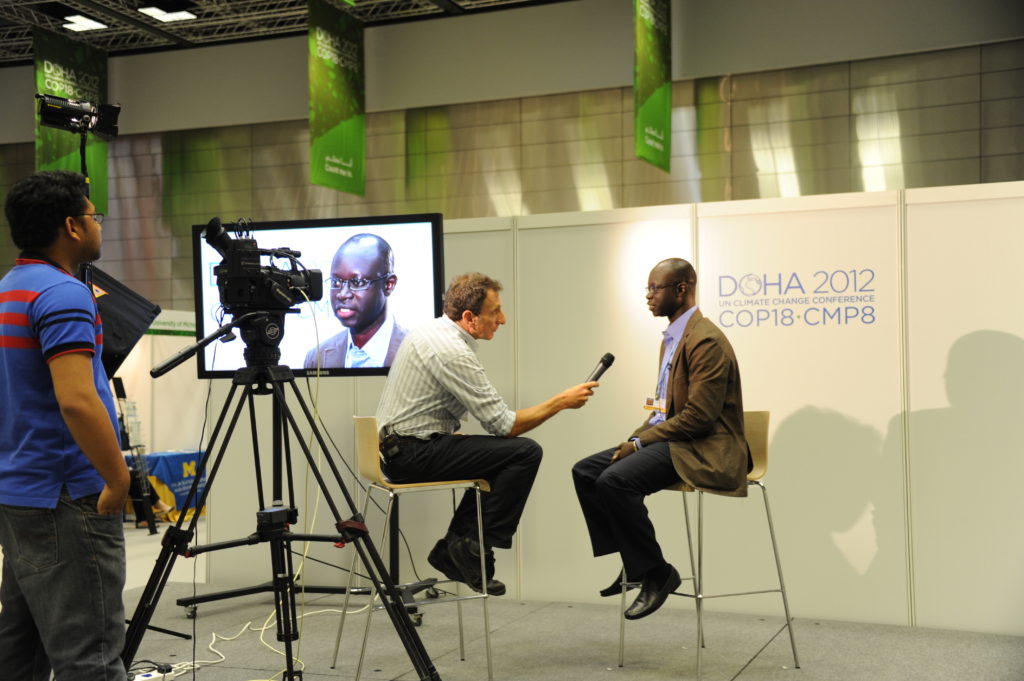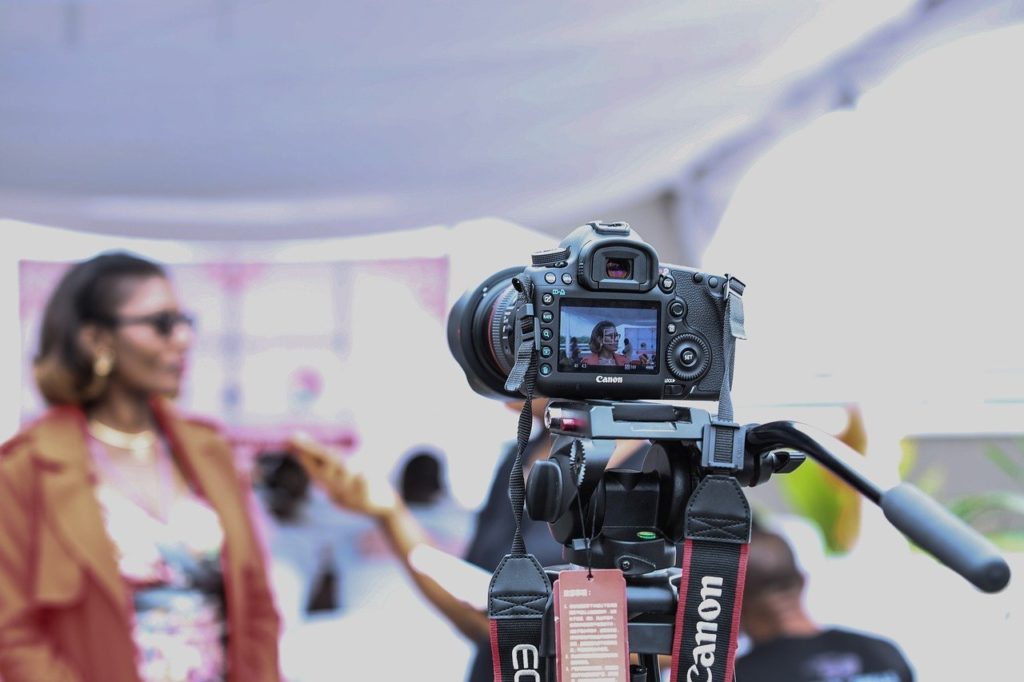Part 3: The Medium
3.3 Mainstream Media
Learning Objectives
- To identify the features of the mainstream media environment and how they might impact your communication effort.
- To explain how to foster trust and credibility and why doing so is important when interacting with the media.
- To describe the interview process and how to prepare for each step of the process.
- To be able to use a variety of principles, tools, and techniques to deliver an effective and impactful interview.

Media is narrative! If you are going to be impactful at using the mass media, then mastering the art of the narrative is essential.For most people, the idea of talking to the media can be terrifying. Nonetheless, mainstream media is one of the most effective methods for sharing information with the public, raising the profile of neglected issues and reducing community outrage. Indeed, the reason that we are nervous about contacting the media is precisely the reason that it is so useful – it gets the word out far and fast. However, it is important to become comfortable with mainstream media because if an issue catches the media’s attention, it will be reported on with or without your involvement. Although it might be scary and you might mess up every now and then, it is always better for you to be out there telling your own story. If you don’t, someone else is going to tell it for you.

The media environment
Before we coach you on how to interact with the mainstream media, you first need to view mainstream media as a complicated and dynamic environment that is influenced by a diverse array of factors. This environment can have profound impacts on the way stories are told and interpreted.
The media outlet
Each outlet has its own ‘flavour’ that will influence the topics featured, preconceived perspectives/biases on specific issues and the way a story gets presented. Before you agree to an interview, make sure you understand the outlet and whether it aligns with your mission and message.
The media medium
Print, TV, radio, and web-based news all tell stories in different ways. For example, print stories can provide the most information (i.e. detail, context and background) and are headline driven. TV needs strong video images and is often driven by emotions. Radio needs compact stories with catchy sound bites. News sites are driven by sensational, ‘click bait’, headlines and content can be inaccurate given the medium’s incentives for quick turnarounds on stories. However, depending on the outlet, there is opportunity for depth of writing too.
The reporter
There is tremendous variability among reporters with regard to their skill, style and experience. Additionally, many reporters who have experience reporting on a topic will often have their own opinions and biases that will undoubtedly colour the stories they tell. Again, before agreeing to an interview, do a brief internet search on the reporter and the pieces they have previously written to see if they will be the appropriate conduit for your message.
The timeline
In the current media climate, everything is about speed. For the most part, investigative journalism is a niche market. Most reporters aspire to ‘break the story’ and may be willing to sacrifice accuracy if it means that they will be the first to report on an issue. Many even have to turn around multiple stories in a single day. This means that you will have to respond to requests immediately and be agile enough to prepare for an interview with a few hours’ notice (or less).
The current events
Reporters and outlets have only so much bandwidth or air time to play with each day. If a high-profile story crops up, then your interview may be cancelled, or moved to the back pages. On the other hand, if nothing is going on, then there may be an effort to create something newsworthy, which can result in unanticipated attention for a previously low-profile issue. If your issue is somehow related to a high-profile event or has caught the public’s interest for some reason, then you may get a flood of inquiries all at once.
Discussion
Credibility and Trust
Relaying your message is only part of your objective when talking to the media. Your overarching goal should be to build credibility or, better yet, trust. If you are credible, then people will believe you. However, if they trust you, then they are more likely to actually do what you say. In other words, trust is going to be what helps you to actually achieve your mission.
Interestingly, expertise is only a small component of trust-building. The perception that you are dedicated to the issue and that you are open and transparent are equally important. However, what is most important is that people feel that you are empathetic—either to them, to those affected by the issue in question, or even to your opposition.

The interview process
Decide on the best spokesperson
This has to do with subject area expertise but also with perceived social ranking. For example, if there is a high-profile political issue, then it is probably better for a Minister to do the interview rather than one of their staffers. Bringing the ‘big guns’ is a sign of respect and an indication that your organization is taking the situation seriously. If you decide you are the best spokesperson, be clear on who you are speaking on behalf of—are you representing just yourself or your entire organization? This is particularly important if you take on multiple roles.
Set the terms of engagement
Start by negotiating the interview terms. When a reporter first makes contact, you need to interview them! Ask for their name, which outlet they are with, their approach to the story, why they want to speak with you, and what they know so far. If you are willing to proceed, then you can set a reasonable interview time (you don’t have to agree to be interviewed immediately). You should also clarify the perspective, objective, and parameters of the interview. For example, you should be clear about your affiliation and expertise (i.e., who are you speaking on behalf of), as well as what you are and are not willing to talk about.
Have an agenda
This is essentially the same as your mission, or it could be a goal that serves your mission. You need to be very clear to yourself and the reporter what you are hoping to get across by doing the interview.
Be prepared
Think about who your audience is. You are probably thinking ‘the general public’, but this is almost never the case. Rather, you are speaking to a subset of the public. If you are talking about infant nutrition, you are speaking to young mothers. If you are talking about pharmacare, then seniors are probably your target. You need to tailor your message and language accordingly.
Know your story so well that you don’t need a script
If you are going to give a good interview, you have to genuinely respond to questions as they are asked versus just repeating talking points. Reactivity, as previously discussed, is crucial here. Moments of emotion and spontaneity are what is going to make you memorable, and that is only possible if you are not having to think too hard about your answers.
Decide what information to include and what to omit
Part of this is setting the terms of engagement with the reporter. But you also need to be crystal clear on this yourself so that you don’t get led down a line of questioning you are not prepared to deal with.
Get ahead of the game
Try to anticipate difficult questions that might come up and have a way to address each of them. As you give more interviews, you will gain a better sense of the kinds of questions interviewers will ask.
Keep control
This does not mean that you should try to control the reporter or that you should try to override them by continuously repeating the same message. Rather, it means that you should keep control over the way you interact with the reporter and the way you answer questions. For example:
- If you are not sure what they are getting at with the question, you can ask them to clarify or you can rephrase the question so that it makes sense to you.
- You can challenge the premise a question is based on.
- You can pose your own questions to answer if they are interesting and important.
- You can take time to think about a question – don’t feel that you have to launch into an answer immediately.
Build a rapport
Try to build a rapport with the reporter and your audience by being likable and telling a great story.
Deliver your message
Good interviews start with the conclusion and then present the facts and premise. Poor interviews get caught up in the background and wait too long to get to the point.There are a number of tools that can help you do this:
- Expend the time and effort to craft great ‘sound bites’ or ‘one liners’ that really capture the essence of your message. Memorable quotes are more likely to be included in the story or even used in the headline or the leading paragraph.
- Think of a media interview as the mirror image of the normal scientific process. You need to lead with the conclusion (the headline!) and then follow that up with supporting facts.
- Your conclusion is what is going to get people interested and hold their attention while you discuss the background and/or data. If you don’t start with the hook, people will not wait around to hear the rest.
- Leave an impression. At the end of the interview, the reporter will often ask if there is anything that you would like to add. This is the time to repeat your key messages to ensure that your audience is left with a clear impression of what you had to say.
- Use plain language. Speak at the level that a Grade 8 student can understand. Avoid jargon, technical terms and acronyms. Use accessible analogies and examples to explain complex topics. It is more important to be understandable than to be 100% technically accurate.
Developing and delivering a trustworthy message
Verbal Cues
There are a number of ways to adapt or supplement your message to increase public trust.
- Make it clear that you are genuinely concerned about the issue in question and the people most affected by it. You can also explain to your target audience why they should be concerned.
- Identify ways in which you or others can respond, preferably in an immediate and relevant manner. You might also give your target audience some ideas regarding what they can do.
- Describe or demonstrate your expertise or that of the people working on the issue.
- But still be a likeable and relatable human being! This is a fine balance—you want people to connect with you while feeling you are capable of dealing with the problem at hand.
- Demonstrate your dedication by describing previous commitments that you have lived up to or by making commitments that you can and will live up to.
- Where possible, back up your statements with concrete examples and supporting facts. This will help to further increase your credibility.
Non-Verbal Cues
It is also extremely important to remember the impact of non-verbal communication to the overall success of your messaging.
Body language
Eye contact is probably the most critical tool for building trust. However, you also need to be mindful of your posture, hand position, and head gestures. For example, if you have your hands on your hips or your arms crossed, you might come across as aggressive or confrontational. Meanwhile, having your hands in your pockets seems disengaged and dangling hands at your sides is just plain awkward. Instead, keep your hands between your waist and heart and use them to gesture appropriately along with your speech in order to draw people in. Ideally, you should stand square to the reporter with feet shoulder-width apart. If you are sitting, lean forward slightly. Nod your head if you agree and shake your head if you disagree. Avoid fidgeting and other nervous mannerisms and avoid moving around if you are being filmed or have a stationary microphone.
Para-verbal communication (i.e., voice intonation, speed modulation)
Seek out a tone of speaking that fits with your message. Speak in a natural way but use breath, cadence, modulation, and pauses to pace yourself, help people follow your story, and draw attention to the important parts of your message.
Other visual elements
Think about what your wardrobe and setting say about you. If you are trying to connect with ‘everyday people,’ then wearing flashy and expensive clothes might not be the best approach. If you are trying to calm people down, then make sure that the setting is not alarming (e.g. people running around in hazmat suits in the background). If you want to show that you care about an issue affecting the community, then you might want to do that interview in a community setting rather than in your office.

Media dos and don’ts
- Don’t ignore a media request. You can respectfully decline, postpone your decision, or agree to speak at a later date, but always respond promptly.
- Do be prepared for media requests. Anticipate situations in which you will be approached by the media. Before you even get the request, prepare your message and get clearance beforehand from supervisors, colleagues and other relevant individuals to deliver that message.
- Do address every question though you don’t need to answer them all. Always address the question you are asked in a straightforward way. There is nothing more annoying than hearing someone spout the same canned response regardless of the question. However, if you don’t feel that you can or should answer the question, explain why and bridge onto another message (see next point).
- Do find the bridge. If you are asked a question that is off topic, you should try to find a way to connect, or bridge, that question to your main message.
- Do decline to answer questions that you are not comfortable with. Don’t just say ‘no comment’—explain why you cannot answer the question (e.g. you don’t know enough yet, you are not the expert, the answer is confidential). Similarly, if you are uncomfortable with a line of questions, put it to an end rather than trying to talk your way out of them.
- Do acknowledge the outrage. If you are dealing with a controversial issue, always acknowledge the outrage and opinion of your opposition, even if you don’t agree with it. If you ignore these factors that are not ‘on message,’ you will come across as cold, out of touch, incompetent and untrustworthy. Outrage and opposing viewpoints are sort of like vampires or monsters in your closet—they are a lot less scary if you bring them out into the light. Up front acknowledgements clear the air and make it easier for you to engage your audience.
- Do admit to your mistakes. If you or your organization made a mistake or acted in a way that is viewed negatively by the public, admit your shortcomings and commit to doing better. Paradoxically, admitting your shortcomings actually fosters trust.
- Don’t make stuff up. Moments of candor and improvisation can lead to fantastic interviews. However, they can also result in disaster depending on what comes out of your mouth. Be particularly careful about improvisation where the tone of the interview is hostile or aggressive. When you are defensive, you are more likely to say something that you will later regret.
- Don’t lie or mislead with silly language. Trying to sugarcoat a bad situation or event will make you look worse, not better.
- Do help the reporter help you. The better prepared the reporter is for the interview, the better the story will be. If you can, provide additional resources and links that support your message; visual and audiovisual content is optimal. You can also ask to have a background discussion with the reporter prior to the interview to provide context and to frame the story.
- Don’t repeat a loaded question. This will cement the association in the audience’s mind. Similarly, don’t repeat accusations or inaccuracies. For example, in 1973, Richard Nixon tried to quell outrage regarding the Watergate scandal by delivering a speech in which he said “I’m not a crook.” Unfortunately, the word ‘crook’ was permanently attached to Nixon from that time onward.
- Do use your emotions wisely. Emotions can be very good for delivering an effective media message. They help your audience to connect with you and build trust. However, uncontrolled emotions can derail an interview. Above all, make sure you keep your perspective and composure. Reporters may intentionally try to create conflict or rile you up to get a better story.
- Do keep your responses punchy and short—make your point and stop in a clear and punctuated way.
- Do make sure that the facts presented are true and accurate. Immediately and calmly correct any misstatements made either by yourself or by the reporter.
Additional tools for your media tool belt
Framing
Framing describes how you use words to influence the way your audience perceives the story. This includes what aspects you will emphasize, how you compare to and contrast with other issues, and how you use analogy, metaphors and examples. Framing is used to help your audience appreciate the mental picture you are trying to paint for them.
Flagging
Use words to emphasize important ideas or messages, such as explicitly saying, “The most important point is…” or “I feel strongly that…”
Redirection or pivoting
This is about changing the question or its premise. It involves acknowledging what the reporter is asking but politely suggesting an alternative line of questioning you feel is more important. You can redirect a question by saying, “The more critical question right now is….” or “For me the real issue is…” or “How I look at this is…”
Defer
If you could answer a question but don’t want to for some reason, then don’t. Instead, explain why you can’t answer at the moment and when the question will be answered. But make sure you use the right language. A good way to defer a question is to say, “It would be inappropriate for me to comment until….”
Deflect
If a question is outside of the scope of what you are willing to talk about, say so and explain why. You might suggest an alternative expert but be careful about publicly naming someone without their prior permission.
Positivity
Where possible, focus on what you can do, are doing, or will do. Avoid repeating what has not been done or what can’t be done.
Recap
Take opportunities to repeat your main message, particularly at the end of an interview.
Interview examples: The good, the bad, and the ugly
Example
The good
- In “BC health officer fights back tears amid latest COVID-19 infections“, Bonnie Henry was able to develop public trust by making it clear that she was genuinely concerned about the issue in question and the people most affected by it. She was also able to effectively use emotion to connect with her audience.
- Naheed Nenshi used a different style to warn people to stay away from the Bow river during the 2013 Calgary flood. He is direct, clear, bold, humorous, and memorable.
- In 2008, Maple Leaf Foods’ packaged meat products were the source of a listeria outbreak. The company could have followed the traditional corporate response of denying and ducking responsibility, and fighting affected consumers in court. However, the company decided on a different communication strategy, which likely saved the company. As explained by Tony Wilson of the Globe and Mail, “First, [Maple Leaf Foods] admitted it was the company’s fault. It admitted it was responsible. It said, in essence, ‘it’s our fault and we’re going to fix it.’ Second, Maple Leaf apologized. It wasn’t wordsmithed or spin-doctored to deny culpability. The company didn’t dodge the issue. It apologized up front in every possible media. Third, it didn’t hire a celebrity to deliver the apology, or a blonde actress with very white teeth wearing a lab coat. CEO Michael McCain was the voice and face of the crisis, and of the apology.”
Note also the setting and wardrobe in the video below—McCain is clearly trying to connect with consumers and not look like the wealthy CEO that he actually is.
Example
The bad
- In 2015, outgoing Chief of Defense Staff General Tom Lawson did an interview with the CBC’s Peter Mansbridge about a range of issues associated with the Canadian Armed Forces. The interview went haywire when Mansbridge brought up the issue of sexual harassment in the military. Lawson clearly started to improvise and came up with a poorly thought out and factually indefensible response—that sexual harassment is still an issue in the Canadian Armed Forces because people are just “biologically wired” in a certain way. It also demonstrates the masterful interview techniques employed by Mansbridge, who clearly waited to bring up the topic midway through the interview, when Lawson was feeling comfortable, and used their warm rapport to make the question seem less controversial than it actually was.
- Stephen Duckett, president and CEO of Alberta Health Services, made a fatal error by refusing to speak with reporters about the province’s ER crisis…. and it cost him his job. It is understandable that Duckett was annoyed by being hounded by reporters on the way to a press briefing. Nonetheless, he should have anticipated the possibility of an ambush and been prepared to politely re-direct reporters to the briefing. Instead, he made it appear that he was too busy eating a cookie to care about Albertans dying in ERs.
Example
The ugly
- In 2013, one of MMA Railway’s trains derailed and set off a series of fatal explosions in Lac-Megantic, Quebec. The full press conference given by the president of Rail World Inc., MMA Railway’s parent company, was almost a half hour of pure agony and offered a laundry list of what not to do. For example, not only does the president Ed Burkhart not take responsibility for the accident, he blames it on an employee. While he does apologize, his apology comes across as insincere because of his condescending and defensive tone and manner. Ed makes a number of comments that are flippant and insensitive, and he conducts the entire press conference in English with no translation despite the fact that he is in a French-speaking town. For a more manageable dose, focus on the segments at 21:30 and 25:00 or see CBC’s take on the interview, below.
Takeaways
Takeaway Tweet
“Those who fail to plan, plan to fail.”
A good communicator will do research and practice before media interviews, presentations or stakeholder meetings!
Being prepared will
🗹 Build credibility
🗹 Reduce chance of mistakes
🗹 Focus the message & messaging
🗹 Maximize audience engagement
– Julie Zhang
Key Takeaways
- The mainstream media is a complex and dynamic environment. Consider this carefully when deciding which interview requests to accept and in preparing your message.
- Be prepared—know your story front and back, set terms of engagement and anticipate questions.
- Your overarching message should be to build credibility, and if possible, trust in the eyes of your audience.
Media Attributions
- Climate Change TV Interview © UNclimatechange is licensed under a CC BY (Attribution) license
- Women speaking on camera © Pexels is licensed under a CC0 (Creative Commons Zero) license

